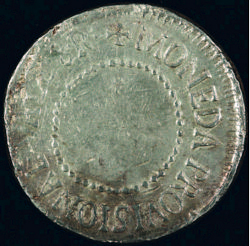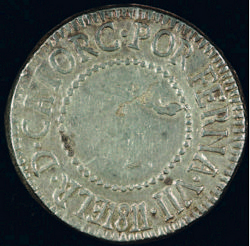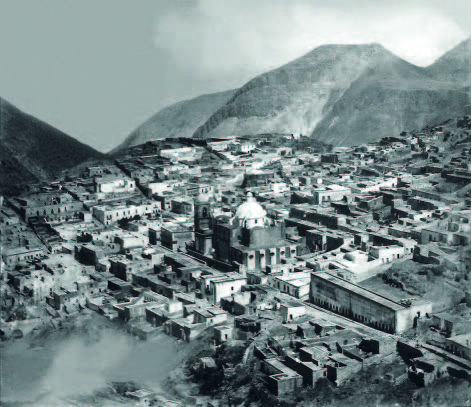The Second Insurgent Issue: Real de Catorce 1811
by Max. A. Keech
Less than two months after Insurgent forces issued their first coinage in Zacatecas, they struck their second in Real de Catorce. Insurgents under Lt. Coronel José Mariano JiménezJosé Mariano Jiménez (18 August 1781 – 26 June 1811) was a leading figure in the early War for Independence, second only to Hidalgo and perhaps Ignacio Allende and Juan Aldama. Jiménez was born in San Luis Potosí and educated as a mining engineer at the Colegio de Mineria in Mexico City where he graduated in 1804.
He joined Hidalgo in Guanajuato at the start of the revolution, rising quickly to the rank of Lieutenant Coronel. Jiménez played a key role in the Insurgent victory at the Battle of Monte de las Cruces following which he traveled to Mexico City to ask the Viceroy for the surrender of the City! Shortly after, Jiménez was given command of the Province of San Luis Potosí. After subduing San Luis Potosí and the surrounding provinces, he took Saltillo and then marched on Chihuahua with Hidalgo, Allende, Aldama and a thousand men. He had a reputation for kindness to captured Spaniards and Royalist soldiers, often releasing them with letters of safe passage. After an act of betrayal by a subordinate, Jiménez, Hidalgo, Allende, Aldama and 900 of their men were captured at Baján. Following a trial, he was executed by firing squad, decapitated and his severed head displayed in an iron cage on a corner of the Alhóndiga de Granaditas in Guanajuato along with the heads of Hidalgo, Allende and Aldama.
He now rests in a mausoleum at the Independence Column in Mexico City. captured the Province of San Luis Potosí in early December 1810 and in January-February 1811 struck the very rare Real de Catorce silver eight reales. This coinage has been incorrectly cataloged in most references A noteworthy exception is the description of the ex-Huntington specimen sold in 2012 by Jesús Vico as a Royal Provisional issue but can now be conclusively attributed to the Revolutionary forces, based on contemporary sources presented below.


1811 Real de Catorce 8 Reales
At the end of October 1810, just six weeks after the revolution began, Royalist General Calleja marched his troops from his base in San Luis Potosí to retake Guanajuato by way of Aculco and Celaya. Shortly after his departure, an insurrection began at the Carmelite convent which succeeded in delivering the unprotected city to the Insurgent cause. Hearing of the successful revolt, revolutionary Insurgent General Iriarte marched from Zacatecas to plunder San Luis Potosí. As in Zacatecas, when word of the Insurgent advance arrived, the Spaniards and loyalists fl ed with their belongings. They went to Saltillo or the coast taking most of the money in the province with them. Iriarte plundered what was left but quickly returned to Zacatecas. Father Hidalgo placed Lt. Coronel José Mariano Jiménez in command of the province of San Luis Potosí. Jiménez and his Insurgent forces quickly controlled the entire province including Real de Catorce Real de Catorce is a rich mining city 260 km (160 miles) north of San Luis Potosí and about 25 km from Matehuala. It is located at an elevation of 2,743 m (9,000 feet) in the Sierra de Catorce region of the arid Mexican plateau. The name “Royal Fourteen” relates to a platoon of fourteen Spanish soldiers killed here by the native Chichimec Indians shortly after the conquest. Silver was discovered here in 1772 and its mines were among the richest in Mexico.and Matehuala. Jiménez entered the town of Real de Charcas on 8 December and Matehuala on the 14th. Jiménez issued a proclamation in Matehuala on the same day, inciting the populace to denounce any Spaniard opposing the insurgents, and also denouncing opportunists claiming to support the revolution but dedicated to robbing instead.
The goal, as with Zacatecas, was to recruit men and to seize the wealth of the silver mines. Real de Catorce was the most productive mine in the Province. The remaining population was sympathetic to the movement and Insurgent General Jiménez was successful in recruiting thousands of men.
 Real de Catorce, circa 1893
Real de Catorce, circa 1893
At Real de Catorce, the mines were opened and the silver obtained there was used to strike a Provisional 8 reales in January-February 1811. Lt. Coronel Jiménez also established foundries to make weapons in Real de Catorce and other locations. On 7 January with a force now numbering 10,000, Jiménez extended his control north to Saltillo. The Insurgents would hold the province until 20 February 1811. After retaking Guanajuato and Guadalajara, the Royalist General Calleja returned to reclaim San Luis Potosí. The Insurgents retreated from the province ahead of his arrival, consolidating north towards Saltillo. Calleja entered San Luis Potosí around 5 March 1811. Based on this time line we can confidently place the Insurgents’ 1811 Real de Catorce coinage in the first two months of the year In El Real de Minas de la Purímísa Concepción de los Catorces (S.L.P.,1993, p. 219-221) Rafael Montejano y Aguiñaga correctly attributed this issue to Jiménez but mistakenly assumed it was struck between 20 and 25 December 1810. He concluded this because Lt. Col. Jiménez was known to be personally in Real de Catorce on those dates. By January/February Jiménez had marched towards Saltillo but his forces still controlled the entire province which remained under his command from December thru February 1811: therefore there is no reason to conclude this coinage dated 1811 was struck earlier.[/footnote}.
The design is somewhat crude and simple with the obverse legend “EL R. D. CATORC. POR FERNA. VII. 1811” proclaiming for the imprisoned King. The reverse legend simply states “MONEDA PROVISIONAL. VALE. 8. R.” As with the Insurgent/Local arms LVO issue, the Proclamation for Ferdinand has mistakenly led to its attribution as a Royalist issue“POR FERNA. VII.” can be translated as “In support of Ferdinand VII” of “For Ferdinand VII”. Recall that Ferdinand VII was imprisoned by the French and Joseph Bonaparte occupied the Spanish throne. Many mainland Spanish bureaucrats, nobleman and clergy accepted this situation but not the New World inhabitants. They viewed the mainland sympathizers as French puppets. According to Spanish law, in the absence of the King, sovereignty rested with the people to hold in trust until legitimate authority was restored. The Insurgent leadership professed loyalty to their imprisoned King, claiming to hold sovereignty until his return. The revolutionaries marched from Dolores to Guanajuato under Ferdinand’s banner. The entire coinage of the Independent Supreme Junta government from 1811 to 1814 would carry the proclamation of Ferdinand, as would the Insurgent issues at Zongolica. It was only later in the war that Morelos would separate himself from other Insurgent leaders by disavowing loyalty to the King.
On 21 March 1811, Lt. Coronel Jose Mariano Jiménez was captured with Insurgent leaders Miguel Hidalgo, Ignacio Allende, Juan Aldama and over 900 of their men at Acatita de Baján (Wells of Baján). He was taken to Chihuahua to face treason charges where he was convicted and shot as a traitor on 26 June 1811. Jiménez ’s trial testimony has survived and provides convincing evidence of the Insurgent origin of the provisional coinage of Real de Catorce. On 22 May 1811 the 30-year-old revolutionary prisoner gave testimony. A summary of the relevant portions of his testimony is as followsPradeau and others have published English translations which vary slightly but not on any significant facts. This summary is based on Pradeau’s translation. While not a direct quote, all relevant facts and events are unchanged.
Jiménez was asked if he understood the reason for his detention, knew who captured him and if he knew the roles the other prisoners (Miguel Hidalgo, Ignacio Allende and Juan Aldama) played in the insurgency.
Jiménez replied that he was aware of the cause of his imprisonment and the roles the others had played in the insurgency. He was aware that he was apprehended by Captain Don Ignacio de Elizondo commanding a garrison from the town of Coahuila.
Jiménez was then asked if it was true that he had gathered militias, fabricated weapons, issued coinage in this province and neighboring areas, had imprisoned and supplanted the legitimate authorities, had issued proclamations and edicts and had proposed an alliance with the United States.
Jiménez answered that it is true that he had gathered his garrison in San Luis Potosí and added troops in El Venado, Charcas, Matehuala and Catorce. He acknowledged that he had fabricated weapons such as spears and cannons in Matehuala and Catorce and that he issued coinage in silver of full fineness and intrinsic value in Real de Catorce. He said that it is true that he imprisoned the legitimate authorities and replaced them with his appointed men, and that he has indeed issued proclamations and edicts. He said that all these actions resulted from his need to preserve his safety by embracing the insurrection despite being well aware of its consequences. Regarding the minting of coinage, he said that he had only minted coinage following the example of Zacatecas (Insurgent LVO issues) to provide a circulating media, but always being careful of not harming the King’s interests by giving it proper weight and full intrinsic value.
Jiménez’s testimony is conclusive evidence that this rare provisional coinage is the second Insurgent issue and it reaffirms that the Insurgent/Local arms LVO of Zacatecas was the first. Interestingly, he places Insurgent General Iriarte near Catorce during this time. While it is uncertain who served as the insurgent mint master and who created the dies at Catorce, you may recall that the silversmith Manuel Ramos served as the Insurgent mint master and die engraver at Zacatecas under Iriarte Manuel Ramos would continue his role as Mint Master in Zacatecas after the Royalist take over. We conclude therefore that he was not considered a revolutionist but rather a technician under orders. Perhaps Iriarte ordered Ramos to set up the mint and dies at Real de Catorce. Jiménez’s testimony about the intrinsic value of his Real De Catorce coinage is an understatement as all known specimens weigh at least 30 grams compared to a Royal standard of 27 grams
Additional contemporary evidence includes an 1811 edict by the Governor of Coahuila, Antonio Cordero y Bustamante, which authorized acceptance of the Insurgent coinage. The relevant portions of the edict, published in the capital city of Monclova on 11 May 1811 are summarized as follows:
The crimes of the insurrection have obstructed and harmed all commercial and mining activities. In order to reestablish order and for the benefit of the people, the coins minted by the insurgents in Zacatecas, Fresnillo and Catorce are to be accepted as legal tender in the province under my authority. These coins are to be accepted in addition to the coins of independent American type, and those minted by legitimate authorities in Sombrerete and Durango, with the understanding that when the circumstances permit, the coins of the insurgents will be recalled on account of the King by paying the full face value to their owners.
The Insurgent eight reales of Real de Catorce was plentiful enough to circulate in the province of Coahuila, yet it is quite rare today. With a silver content of nine reales the Insurgents were incentivizing its acceptance. This one real premium was an irresistible attractant to the melting pot and helps explain its current rarity. While a little outside of Gresham’s Law’s normal application, similar forces are at work (Gresham’s Law states that “bad money drives out good”). Incredibly, there are two different types of this very rare Insurgent coinage. The first type of eight reales bears the date 1811 on the obverse and has been plated in all standard references. The second type has an additional date on the reverse with the abbreviated legend PROVIS(IONAL). This second type has not been plated in prior references and its only mention was by Yríarte who states “pieces with date on reverse are known to exist” José de Yríarte, Catalogo de los Reales de a Ocho Españoles, 1965, p.122.
To conclude, we can now comfortable move the Real de Catorce coinage from the Royalist to the Revolutionary camp. It is the second Insurgent issue of the War for Independence!
